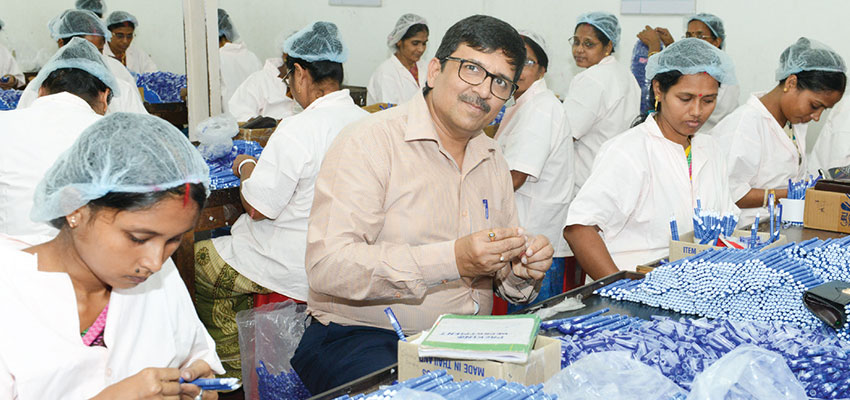Power of the Pen

Modern technology has helped advance the humble pen’s look and market, and the `10000 crore sector is currently estimated to grow at a CAGR of 6.2% over the next three years. Forging ahead in the plethora of brands is Kolkata-based Linc Limited, which has risen from its humble beginnings, gaining prominence in India and the export markets. Linc has a global presence and is distributor of globally renowned brands, Uni-ball, Mitsubishi Pencil Co., Japan, and the Deli brand from the China-based stationery giant. Corporate Citizen speaks to Deepak Jalan, Managing Director, Linc Ltd, who has built upon the visionary foundations of his father, Surajmal Jalan, and the multiple business transitions tracing 47 years of the brand’s history, its present standing, and future aspirations
"Our innovations are not at the expense of our traditional values, and while boldly embracing the future, we ensure that our brand remains relevant for generations to come"
Managing Director of Linc Ltd, Deepak Jalan says that his leadership combines strategic vision, adaptability, and a relentless commitment to innovation. “In the dynamic landscape of the pen manufacturing industry, adaptability is crucial, and I strive towards a forward-thinking approach, anticipating market trends and embracing change,” he adds.
Jalan acknowledges his educational qualifications that have deeply influenced his business journey. “My B.Com (Hons.) degree from University of Calcutta built my understanding of accounting, finance, marketing and management skills. It enabled me to understand the complexities and nuances of the business landscape”, he said. His professional acumen was significantly marked by his participation in the Business Leadership Programme at IIM Calcutta, which enhanced his advanced concepts in business strategy, innovation and entrepreneurship.
A recipient of the Export Excellence Awards, consecutively for 10 years, Jalan was adjudged for the ‘Best New Entrepreneur Award’ in 2005-2006 by the Bharat Chamber of Commerce. He received the CNBC Emerging India Award for the SME category in 2005 and was the President of the Merchant’s Chamber of Commerce and Industry (2012-13).
Birth of a legacy
Although Linc India sustains a daily production capacity of 2.5 million writing instruments, the Jalan’s were not always synonymous with the writing instrument sector. It took Deepak Jalan’s father, Surajmal Jalan, many business transitions to build a heritage brand.
Surajmal Jalan (born 1938), hails from Rajasthan and despite his humble beginnings, harboured an ambition that charted his journey. In 1957, Surajmal chose Kolkata for higher studies, as he was drawn by the burgeoning business opportunities in the city. Counselled by well-meaning friends, the move marked the beginning of an extraordinary entrepreneurial passage. Limited financial resources prompted the young Surajmal to work at a carpet showroom on Harrison Road, where he honed his skills in sales, accounting, and general administration. The following year, he joined a comb-manufacturing company. Come 1960, as he marched through life’s phases and into matrimony, he became a manager at a rice mill and the tea gardens in Siliguri, West Bengal, securing a monthly income of `500. However, in 1966, family obligations beckoned him back to his village, where he rebooted his journey. He noticed a market void for quality pens and reploughed his savings of `5000 in door-to-door selling of pens.
The move offered a greater market insight into the pen sector and Surajmal’s entrepreneurial spirit, once again prompted him go back to Kolkata’s bustling business alleys and the famed Bagree Market, where he established a retail counter for pens, gradually expanding it into a wholesale enterprise. His strong desire to manufacture pens eventually gained support from his in-laws, and he established his first factory in a modest 10 ft x 10 ft room in Malapara, North Kolkata. With an initial investment of Rs 10,000, he manufactured plastic parts for ball pens, gradually gaining credibility for his quality products. However, his larger vision was to create a pen brand of his own. Encouraged by U.S. Jain, his close friend, Surajmal fulfilled his goal in 1976, when he launched his pen brand “Linc”.
Sustaining a brand
Deepak Jalan embarked on his journey as a second-generation entrepreneur when he joined the family business in the early 1980s, as a frontline salesperson. “The lessons learned in the formative years have shaped up my approach to business and leadership,” said Deepak Jalan.
With competitors across organised and unorganised sectors vying for a slice of the humble pen pie, the Jalan’s have balanced innovation and tradition within the business landscape. “We deeply respect our heritage and the timeless appeal of our traditional products, which have garnered loyalty across generations. However, we are also committed to innovation, recognising the evolving needs and preferences of our consumers, meeting modern demands while ensuring they embody the classic qualities of our brand,” said Deepak Jalan. He believes in the customer-centric process, which seeks feedback from users and closely monitors market trends. The insights gained, guide their product development, building functionality and design. “Our innovations are not at the expense of our traditional values, and while boldly embracing the future, we ensure that our brand remains relevant for generations to come,” he said.
Deepak Jalan shares his views on building a sophisticated lineage in the entire gamut of the writing instruments and the stationery sector, leveraging latest technology and design thinking, to develop the humble ‘pen’.
"Our flexible and adaptive organisational culture believes that ‘one size does not fit all’. Therefore, we empower our teams across diverse geographies via adiverse geographies via a decentralised approach, arriving at localised decisions, for brand value alignment"
-Deepak Jalan
CC: How do you balance cost competitiveness and product quality?
Deepak Jalan: We delicately navigate our operational efficiencies, fine-tuning supply chains, investing in cutting-edge manufacturing processes, and strategic pricing decisions that bring high-quality writing instruments within reach of a diverse audience. We have adhered to our founder’s commitment of affordability and a customer-centric approach.
CC: How does the FMCG-style of retail distribution impact your business?
The evolving retail landscape prompted us to transform our distribution approach from fiscal 2021, a strategy that has broadened our market reach. We expanded our presence beyond the traditional stationery shops including gift shops, kirana stores, general stores, mom-and-pop stores, paan shops, and tapped into diverse consumer segments. The shift to a “phygital” distribution model was critical as it seamlessly blended traditional feet-on-street distribution with a tech-driven strategy. We incorporated 100 dedicated tele-callers, and our proprietary (software) application, facilitated real-time monitoring of stock availability, strengthening our business relationships. The innovative approach has enhanced the accessibility of our products and positioned the brand effectively in a dynamic and competitive market.
CC: What has been your consumer behaviour learning in the pen market?
We learned that the primary factor influencing pen selection for students and adults was the price, followed by the colour of ink, and finally brand loyalty. Students prefer gel pens categorised by prices, in the `5, 10, 20 products, and those priced above `25 are considered semi-premium and premium. Students tend to exhibit stronger brand affiliation compared to adults, but both groups explored alternative brands if their preferred pen was not available. The pen’s appearance ranked fourth as influential, especially among students.
CC: How do you break the clutter in a ‘me-too’ market?
In a market fraught with identical products we thrive to innovate as we did for three of our pen lines. With the Linc Twinn, we pioneered a product that combined the functionality of a pen and pencil in a single unit, which fulfilled our customer’s writing needs. The Linc Touch pen is integrated with a stylus, that navigates digital interfaces. The most popular has been the design of our Pentonic range, launched in 2018, characterised by bold, neat aesthetics, and a sleek look—challenging industry beliefs that set a new innovative standard in the segment.
"We continuously evaluate our performance in each market, gather feedback from local teams, and build our strategies around them. It allows us to stay agile, ensuring the brand’s consistency, identity, and values across our diverse business landscapes"
CC: What are the emerging trends in the industry?

In 2023, the global writing instruments market size was valued at USD 17.73 billion and is expected to grow at a compound annual growth rate (CAGR) of 4.4% between 2024-2030. Despite digital devices revolutionising communication, the enduring appeal of handwritten communication builds an emotional and personal connection, driving the demand for quality writing instruments. The shift towards eco-friendly products, including refillable pens and those made from recycled materials, aligns with our environmental responsibility. The popularity of customised plantable pencils as a zero-waste alternative reflects a broader societal shift towards more sustainable products. We strive to innovate within these trends, aligning with market demands, which positions us as a forward-thinking and environmentally conscious industry leader.
CC: How are product lines categorised in the stationery market?
The non-paper category of the stationery market, estimated at `41 billion contributed to approximately 40 per cent of the total stationery market. It is dominated by writing instruments, followed by products for office use, colours, and other adhesive and technical instruments. The market share in revenue terms comprises writing instruments at 79 per cent, pencils at 15 per cent, and other office supplies at 6 per cent, which excludes markers or highlighters, refills, nibs, sketch pens, leads and crayons. Pens can be further subdivided into ballpoint pens, gel pens, and fountain pens, which have lost demand lately.
CC: What are the market dynamics across the sector?
The Indian writing instrument industry saw incessant changes in design innovations, and quality of writing instruments, impacting cost efficiencies. The Indian pen industry is valued at an estimated `32 billion functions with 70 per cent of players in the organised market. Ball pens constitute 60 per cent of the pen market, followed by gel pens at 25 per cent. The industry’s growth at 6-8% CAGR is attributed to the increasing literacy rate (about 74%), resulting in an increased number of school-goers, and a nine percent higher youth literacy rate than adults.
CC: What has been the revenue generation in the highly cluttered pen market?
The vast categories of pens in India could be priced anywhere between `5 to `1,00,000. An estimated 60 per cent of revenue is generated from pens priced at `5 or below per piece, with another 10 per cent from those priced at `10 to `15 or below per piece. While the pens in the `100 to `300 range add to a small percentage of the overall revenue generated, the premium brands have a very minuscule market contribution. The market for pens below `15 per piece grew at an annual rate of 7% to 8%, while pens priced above `15 per piece saw an 8-10% annual growth. The market plays around price sensitivities which are much lower for pens costing between `5-`10 than those in the `10-`20 range.
CC: Share some product-led business innovations.
Despite the challenges of trade barriers arising from the Covid-19 pandemic and the Ukraine war, we have persevered and witnessed a positive trajectory in our export market growth. We have an expanded global footprint, across 40+ countries and a brand presence in 50 countries. We endorse strong market penetration strategies and partnerships in Myanmar, Yemen, Bangladesh, Sri Lanka, and other geographies.
In fiscal 2016-2017 and the years leading up to it, the writing instruments industry faced formidable challenges, in terms of diminishing profit margins. It was a period that tested our resilience and adaptability. A significant turning point was during a trip to South Korea, that familiarised me with a design concept. It redefined our path and triggered the launch of our Pentonic brand which was conceived and inspired by Korean design principles. The product set new records for our company and altered the competitive landscape.
CC: What motivated you to ‘Think Global’?
We recognised the global potential of the writing instrument industry and positioned Linc as a brand synonymous with reliability, innovation, and distinctive product offerings. The journey involved strategic partnerships with international players including Mitsubishi, Uni-ball, and Deli, fostering cross-cultural collaborations and learning. We tailored our products and market strategies, aligning with the diverse preferences across native market dynamics in 50+ countries. Our robust infrastructure, technological integration, and dedicated team helped scale our global operations. Our brand commitment to quality, innovation, and a customer-centric approach has been resonating with our consumers worldwide.
CC: How do you manage the complexities of operating in 50+ countries?
Our multifaceted global endeavour is a three-pronged strategy. We strive to understand unique cultural nuances, preferences, and market dynamics across multiple geographies. It involves thorough market research and engaging with local stakeholders that tailor our products and strategies. Our flexible and adaptive organisational culture believes that ‘one size does not fit all’. Therefore, we empower our teams across diverse geographies via a decentralised approach, arriving at localised decisions, for brand value alignment.
Communication is a critical element, and our clear and consistent messaging is disseminated globally ensuring that our brand values and identity resonate across diverse markets. We continuously evaluate our performance in each market, gather feedback from local teams, and build our strategies around them. It allows us to stay agile, ensuring the brand’s consistency, identity, and values across our diverse business landscapes.
"The shift to a “phygital” distribution model was critical as it seamlessly blended traditional feet-on-street distribution with a tech-driven strategy"
CC: What propelled you to tap the export market?

The stiff competition in the domestic market drove us to seek alternate growth areas, and gain market differentiation. We adopted a blue ocean strategy, shifting our focus towards international markets. The move explored new opportunities beyond the saturated domestic landscape and capitalised on the potential for higher profit margins abroad.
CC: How did you overcome challenges in the export market?
Initially, we encountered several obstacles, including navigating the complexities of international trade regulations, establishing a reliable distribution network, and understanding diverse consumer preferences across different cultures. We invested considerable time and resources in market research, compliance, and building strong partnerships with local entities. We faced competition from countries like China in the initial years, which was mitigated by our superior quality, better marketing initiatives, comparative and competitive pricing strategy. The experience has expanded our global footprint and enriched our understanding of the global business landscape, establishing a strong foundation for future growth plans.
CC: What led to the decision to move for an IPO status in 1995 and the aftermath?
The evolving market dynamics prompted our IPO decision as we recognised the success of public issues during that era. Our decision served a dual purpose, as it provided an avenue to raise essential funds for the company’s expansion and growth initiatives. Also, being listed on the stock market, the brand gained valuable brand equity and recognition. The infusion of funds facilitated strategic initiatives, expansion into new markets, and the development of innovative product lines. The company’s listing enhanced its visibility, credibility and market standing, contributing to a positive brand perception.
CC: Has the next-gen taken the reins of the business?
We remain steadfast in our commitment to transformative growth and innovation. The values have empowered the next generation, led by Aloke Jalan, my brother, and Wholetime Director, and son Rohit Jalan, Executive Director. Rohit’s strategic exports’ insights, marketing, and IT initiatives align with the meticulous streamlining of manual processes and the elevation of our ERP system. Together we are steering an innovative and reputed legacy pen brand.
CC: How do you maintain a healthy work-life balance?
I prioritise personal well-being and relaxation. I am an avid reader of autobiographies and enjoy soothing music. I strike a balance between the demands of leadership and personal interests, that rejuvenates me, fostering a well-rounded leadership perspective.